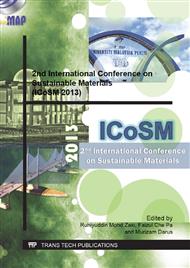[1]
Schiefelbien, G. W. The Ceramic Molding Process. New York: Remet Corporation. 1984.
Google Scholar
[2]
Rahman, M. N. Ceramic Processing and Sintering. 2nd ed. New York: Taylor & Francis e-Library. 2005.
Google Scholar
[3]
Zawati Harun, Gethin, D.T., Lewis, R.W., Combined Heat and Mass Transfer for Drying Ceramic(shell) Body. The International Journal of Multiphysics. 2008. 2 : 1-19.
DOI: 10.1260/175095408784300270
Google Scholar
[4]
Zawati Harun, David Gethin, Drying(Consolidation) Porous Ceramic By considering the microscopic pore temperature gradient, Applied Mechanics and Materials. 2012.147: 210-214.
DOI: 10.4028/www.scientific.net/amm.147.210
Google Scholar
[5]
Hilmas, G., Brady, A., Abdali, U., Zywicki, G. and Halloran, J., Fibrous monoliths: non-brittle fracture from powder-processed ceramics. Materials Science and Engineering A. 1995.195: 263-268.
DOI: 10.1016/0921-5093(94)06525-x
Google Scholar
[6]
Chuayjuljit, S., Eiumnoh, S. and Potiyaraj, P. Using silica from rice husk as a reinforcing filler in natural rubber. Journal Science Research Chulalongkong University. 2001. 26: 127-137.
Google Scholar
[7]
Ramezanianpour, A. A., Khani, M. M. and Ahmadibeni, G. The Effect of Rice Husk Ash on Mechanical Properties and Durability of Sustainable Concretes. International Journal of Civil Engineering. 2009. 7: 83-89.
Google Scholar
[8]
Mwaikambo, L.Y. and Ansell, M. P. Die angewandte makromolekulare. Chemie. 1999. 272: 108-116.
Google Scholar
[9]
Mohanty, A. K., Khan, M. A. and Hinrichsen, G. Surface modification of jute and its influence on performance of biodegradable jute fabric-biopolymer composite. Composite Science and Technology. 2000. 60: 1115-1124.
DOI: 10.1016/s0266-3538(00)00012-9
Google Scholar
[10]
Guerra, J. M. Factors affecting shell strength and the effect of dry time on shell strength. 22nd European Investment Caster`s Federation. South Mimms, Herts, United Kingdom: REMET Corporation. 1992.
Google Scholar
[11]
Zawati Harun, D.T. Gethin, Drying Simulation of Ceramic Shell Build up Process, AMS '08 Proceedings of the 2008 Second Asia International Conference on Modelling & Simulation. 2008 :794-799.
DOI: 10.1109/ams.2008.109
Google Scholar
[12]
Zawati Harun, Nazri Mohd Nawi, Mohd Faizal Batcha and David Gethin, Modeling of Layering Ceramic Shell Mould. Applied Mechanics and Materials. 2012. 232 : 548-552.
DOI: 10.4028/www.scientific.net/amm.232.548
Google Scholar
[13]
Kamarudin, N. H. Reinforcement of rice husk in ceramic shell mould system for investment casting process. M. Eng. Thesis. Universiti Tun Hussein Onn Malaysia, Malaysia; 2012.
DOI: 10.30880/jeva.2021.02.02.011
Google Scholar
[14]
Harun, Z., Kamarudin, N. H., Md Saidin Wahab, M. S., and Badarulzaman, N. A. Shell mould reinforced with rice husk. 4th International Conference on Postgraduate Education (ICPE4). 2010.
DOI: 10.4028/www.scientific.net/kem.471-472.922
Google Scholar
[15]
Harun, Z., Kamarudin, N. H., Badarulzaman, N. A. and Wahab, M. S., Shell Mould Composite With Rice Husk. Key Engineering Materials. 2011. 471-472: 922-927.
DOI: 10.4028/www.scientific.net/kem.471-472.922
Google Scholar
[16]
Banerjee, R. and Bose, N. R. Fibre-reinforced glass/glass-ceramic matrix composites. in: Low, I. M. Ceramic matrix composites; Microstructure, properties and application. Cambridge, England: Woodhead Published Limited. 58-98; 2006.
DOI: 10.1533/9781845691066.1.58
Google Scholar
[17]
Patel, M., Karera, A. and Prasanna, P. Effect of thermal and chemical treatments on carbon and silica contents in rice husk. Journal of Materials Science. 1987. 22: 2457-2464.
DOI: 10.1007/bf01082130
Google Scholar
[18]
Ikram, N. and Akhter, M. XRD analysis of silicon prepared from rice husk ash, Journal of Materials Science. 1988. 23: 2379-2381.
DOI: 10.1007/bf01111891
Google Scholar
[19]
Singh, D., Kumar, R., Kumar, A. and Rai, K. N. Synthesis and characterization of rice husk silica, silica-carbon composite and H3PO4 activated silica. Ceramica. 2008. 54:203-212.
DOI: 10.1590/s0366-69132008000200011
Google Scholar
[20]
Javed, S. H., Naveed, S., Feroze, N., Zafar, M. and Shafaq, M. Crystal and amophous silica from KMnO4 treated and untreted rice husk. Journal of Quality and Technology Management. 2010. 6: 81-90.
Google Scholar
[21]
Tartaj, P., Serna, C. J., Moya, J. S., Requena, J., Ocana, M., De Aza, S. and Guitian, F. The formation of zircon from amorphous ZrO2.SiO2 powders. Journal of Materials Science and Engineering A195. 1996 (31): 6089-6094.
DOI: 10.1007/bf01152164
Google Scholar
[22]
Kumar, S., Kumar, P. and Shan, H. S. Characterization of the refractory coating material used in vacuum assisted evaporative pattern casting process. Journal of Materials Processing Technology. 2009. 209: 2699-2706.
DOI: 10.1016/j.jmatprotec.2008.06.010
Google Scholar
[23]
Remmey, G. B. Firing Ceramics, Advanced Series in Ceramics, World Scientific. 1994(2).
Google Scholar
[24]
Harun, Z., Ismail, N. F., Badarulzaman, N. A., Effect of MgO Additive on Microstructure of Al2O3. Advanced Materials Research. 2012: 488-489.
Google Scholar
[25]
Shukla, D. D. and Juneja, J. L. Effect of different mold layers on fly ash modified ceramic shell strength in investment casting. International Journal of Engineering Science and Technology (IJEST). 2011. 3: 242-248.
Google Scholar


